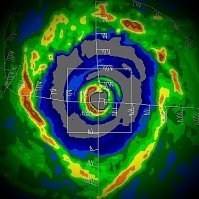-
Posts
4,156 -
Joined
-
Last visited
Content Type
Profiles
Blogs
Forums
American Weather
Media Demo
Store
Gallery
Posts posted by Windspeed
-
-
This has a shot at being a major hurricane by the time it reaches the E. Caribbean. The environment may not be so favorable after that however. Hopefully it slips south of last year's impacts, especially Dominica and north through Puerto Rico.

-
888 WTNT44 KNHC 072058 CCA TCDAT4 Tropical Depression Nine Discussion Number 1...Corrected NWS National Hurricane Center Miami FL AL092018 500 PM AST Fri Sep 07 2018 Corrected bin number from 2 to 4 Satellite images indicate that the low pressure system over the eastern tropical Atlantic has developed a well-defined center and sufficient deep convection to be classified a tropical depression, the ninth one of the 2018 Atlantic hurricane season and second one of the day. The initial intensity is set to 30 kt based on a 2.0 Dvorak classification from TAFB and earlier ASCAT data. The depression has not moved much today, and it has even wobbled a bit to the east recently. This slow motion is a result of very weak steering with broad troughing to the north and Tropical Depression Eight to its east. Little motion is expected through tonight, but a westward motion with a gradual increase in forward speed is forecast thereafter as a subtropical ridge builds to the north of the cyclone. The NHC track forecast lies closest to the HCCA guidance and takes the system toward the Lesser Antilles by the end of the forecast period. The depression is experiencing some influences of easterly shear, which is why the center is currently on the eastern edge of the convection. Little change in intensity is expected during the next 12 to 24 hours since the cyclone is still in the developing stage and because moderate shear is expected to continue. However, the shear is expected to decrease to less than 10 kt in about 24 hours. These more favorable winds aloft combined with relatively warm waters and a fairly moist airmass should allow for steady strengthening beginning later in the weekend. There is a large spread in the intensity guidance, with the HWRF showing the system becoming a major hurricane and HMON showing almost no strengthening. The NHC intensity forecast lies a little below consensus models since it appears that it will take some time for the system to strengthen. FORECAST POSITIONS AND MAX WINDS INIT 07/2100Z 13.6N 34.9W 30 KT 35 MPH 12H 08/0600Z 13.9N 35.2W 30 KT 35 MPH 24H 08/1800Z 14.0N 36.2W 30 KT 35 MPH 36H 09/0600Z 14.0N 37.6W 40 KT 45 MPH 48H 09/1800Z 14.0N 39.3W 50 KT 60 MPH 72H 10/1800Z 14.0N 44.0W 60 KT 70 MPH 96H 11/1800Z 14.1N 48.9W 70 KT 80 MPH 120H 12/1800Z 14.5N 54.5W 75 KT 85 MPH $$ Forecaster Cangialosi -
413 WTNT43 KNHC 072046 TCDAT3 Tropical Depression Eight Discussion Number 2 NWS National Hurricane Center Miami FL AL082018 500 PM AST Fri Sep 07 2018 Satellite data and surface observations indicate that the low pressure system located just west of the coast of Africa has developed into a tropical depression. Conventional satellite imagery shows a well-defined convective band has formed near the center, and microwave satellite imagery has hinted at the formation of an inner ring of convection. The initial intensity of 30 kt and the central pressure of 1002 mb are based on surface observations from ships and the west coast of Africa. The depression currently has good cirrus outflow in all directions. The initial motion is 275/9. During the next 3-4 days, the cyclone should move generally west-northwestward with an increase in forward speed on the south side of the subtropical ridge over the eastern Atlantic. Near the end of the forecast period, a developing mid- to upper-level trough over the central Atlantic is expected to weaken the ridge and allow the cyclone to turn northwestward with a decrease in forward speed. There is some spread in the guidance late in the period, with the UKMET and the Canadian models showing an earlier turn than the other models. The new forecast track, which is similar to the previous track, is in best agreement with the TVCN and HCCA consensus models. The depression is in an environment of light to moderate easterly vertical shear and over sea surface temperatures of 27-28C. This should allow at least steady strengthening, and rapid strengthening is possible based on the hints of the inner core in microwave imagery. This portion of the intensity forecast has been increased to the upper edge of the intensity guidance, with the cyclone forecast to become a tropical storm in 12 h or less and a hurricane between 48-72 h. After 72 h, the system should be over sea surface temperatures near 26C and encountering southwesterly vertical shear due to the aforementioned trough. This should cause at least a gradual weakening. FORECAST POSITIONS AND MAX WINDS INIT 07/2100Z 13.2N 18.6W 30 KT 35 MPH 12H 08/0600Z 13.5N 19.9W 35 KT 40 MPH 24H 08/1800Z 13.9N 21.9W 45 KT 50 MPH 36H 09/0600Z 14.4N 24.5W 55 KT 65 MPH 48H 09/1800Z 14.9N 27.5W 60 KT 70 MPH 72H 10/1800Z 16.5N 33.5W 70 KT 80 MPH 96H 11/1800Z 18.0N 38.5W 65 KT 75 MPH 120H 12/1800Z 20.5N 42.0W 60 KT 70 MPH $$ Forecaster Beven-
 1
1
-
-
This invest has now been classified TD9.
-
92L probably isn't too far from being named either. The broad surface low has clearly tightened, though still impeded by strong mid-to-upper level easterlies.

-
 1
1
-
-
ECMWF continues to maintain W. Atl ridging enough to drive the TC into the E. Caribbean. It does also deepen the system into a hurricane by the time it tracks through the Leewards.
-
Hey, it was something interesting to track. 50-60 mph winds over a good area. Hopefully residential and commercial damage will be at a minimum. Still, flooding is always the worst aspect of landfalling tropical storms with an enhanced moisture feed off the GOM. The event is far from over as Gordon should continue to pull heavy rain into the MS Valley the next few days.
-
 2
2
-
-
Think there could be some precip surprises with this storm. Even though it's having issues at the surface there's plenty of energy at the midlevels to provide forcing to wring out the moisture. Wouldn't be surprised to see some locally 15 to 20 inch totals if it slows as forecasted.
Matters little now but imagining the late week/weekend ECMWF solutions of a slowdown and crawl W-WSW would have been horrible for LA/E TX with this setup. Fortunately this should make its way north into the Mississippi Valley, though the flooding threat could be severe there as well.
-
Nice increase of low-level convergence, inflow with increasing echoes on the east quadrant of LLC. That continuing to intensify will get highest vortex winds down to surface for landfall.

-
 1
1
-
-
This is for perspective of my location.
Good sig of rotation moving toward your location.

-
 1
1
-
-
Latest super-res reflectivity...


-
Gordon has struggled to establish a good surface vortex. Even though it has remained closed and evident at 850-700mb, it's been very weak on the southern side of the LLC from recon data. Stong convergence is occuring right now out of the SSE however and Gordon has good lift into the MLC which is well-established on radar. Nice MCS convection is also represented on satellite above this feature. Given time, this probably would have been a hurricane, and there is a slight chance this can still occur before landfall. I agree this is unlikely though. It's running out of time. However, in place of the strong NE core band, there may very well be some hurricane force gusts in there. Somebody is going to get more than a breezy rain storm.
-
 1
1
-
-
Oh and it looks hot here for six weeks.
Not sure if talking 500mb heat ridge of death or sports?...-
 1
1
-
-
Please stick to the storm at hand. Gordon may very well end up a hurricane, but try to be realistic. It's going to be a small and compact circulation. It may go through RI but it won't be a Katrina, period. It just does not have enough time to get that large.
-
 4
4
-
 1
1
-
-
Gordon could end up microcane if that 850-700 mb vortex works down this evening and deep convection remains consolidated over it. Very small circulation. Though this is a fast mover and that will definitely make for a much weaker southern circulation, it's not the unfavorable atmospheric environment and high speed steering flow in which Nate was imbedded.
-
Deep convection going up right over that center near Marco Island.

-
 1
1
-
-
A little better looking. Noticing some arcing banding fingers on southern inflow. Surface low is probably starting to cutoff. It's weak, but I'd say we're close to this closing.


-
 1
1
-
-
0z GFS OP does little with this system. Only real valuable data is how it handles the upper level environment. No real changes there from 18z.
-
Watching this area closely for genesis tonight. It's the sharpest low-level axis of the wave. Good consolidation of convection could drop pressure enough to do the deed.

-
Upper level environment isn't too shabby per 18z GFS. Certainly negligible shear if this was to verify. Decent postioning of anticylone aloft centered over the SE CONUS to support development. But of course the TC itself is lacking in presentation.

-
This could be anything from a garbage low to a hurricane. Location of genesis and position of track will be critical. For example, if genesis occurs far enough south and a landfall occurs in west LA/E TX, the odds of a favorable upper environment and stronger TC increase. I have noticed that the 0z ECMWF backed off its W to WSW coastal slowdown and crawl however. My original thinking was if that occurred off the coast, a future Gordon would have had serious potential to intensify. Since both major models are pulling this up the Mississippi valley now, I'm much less confident on a hurricane. It's still in question, just not likely in my opinion.
-
Well these are the questions on which I am focusing for each model run the next 3-4 days:
1) How long does it take the wave to close off?
2) Does the northerly 400-200mb flow relax versus ESE flow below 500 mb and how quickly does that occur over the eastern GOM while the TC is developing?
3) How north or south is the track near the mouth of the Mississippi River?
4) When does the slow down and crawl W-to-WSW occur?
-
 1
1
-
 1
1
-
-
I actually think Tennessee will upset West Virginia..
I was wrong, bro.
-
Not being kind to Houston either. High cape and surface convergence off the GOM with a crawling surface low means flooding rains for coastal LA and E TX.



Hurricane Helene
in Tropical Headquarters
Posted
TD8 is forecast to become a hurricane before moving into a more unfavorable upper-level environment over the MDR.